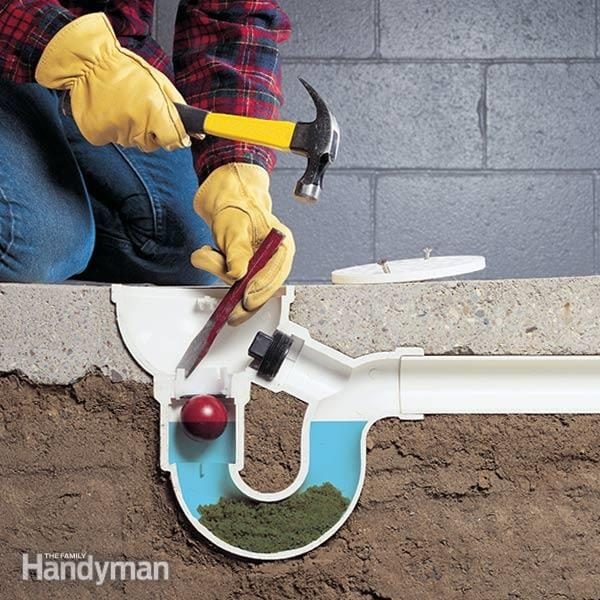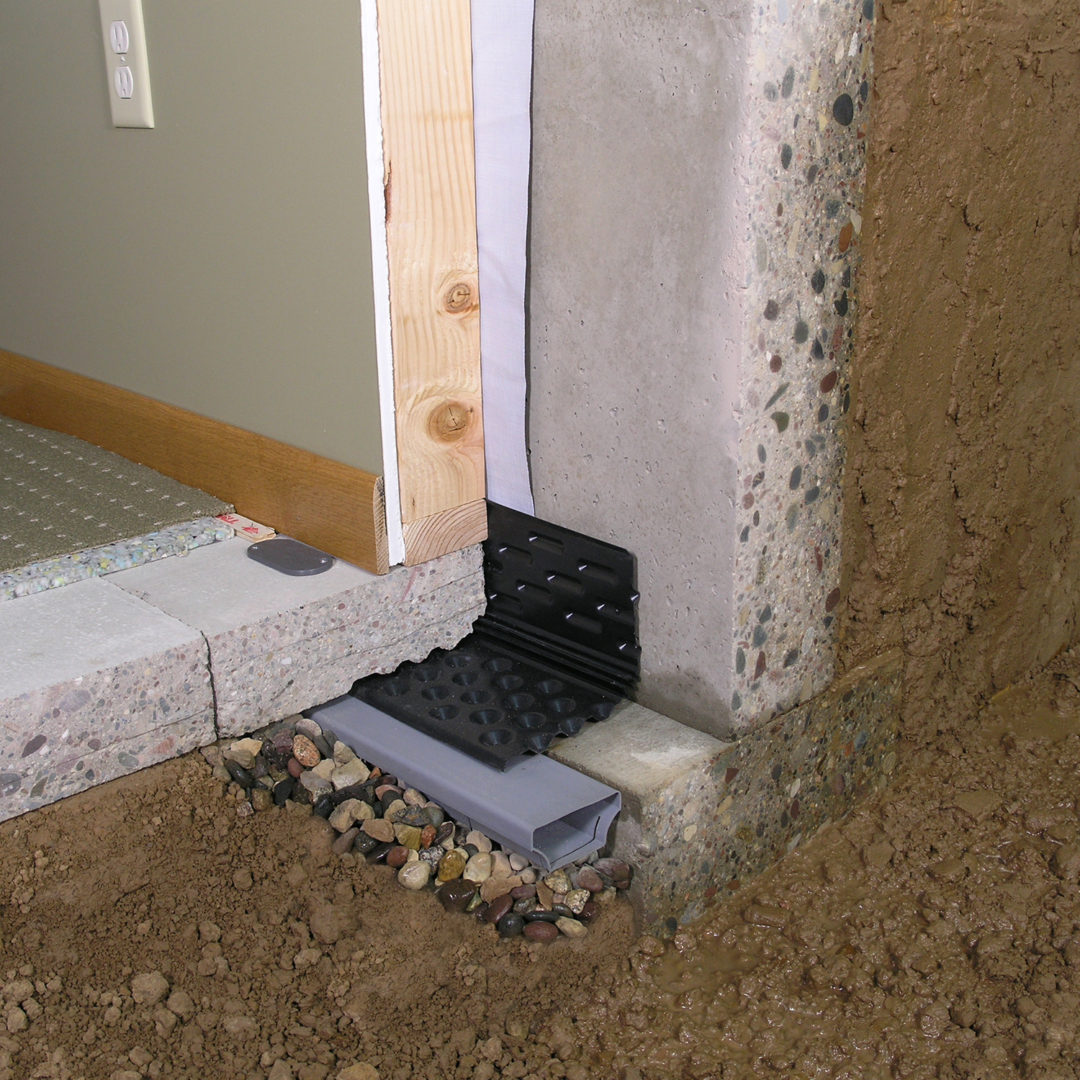You’ve just finished cleaning your basement and step back to admire your handiwork. But then you notice it: a puddle of water lingering in your basement floor drain. It’s a common sight, and one that often sparks panic. Is it a sign of a serious water damage problem? Or is it simply a nuisance you can easily fix? This article will delve into the common reasons why basement floor drains might hold water, exploring the different situations that might cause it and how to effectively address each one.

Image: www.familyhandyman.com
Understanding why a basement floor drain has standing water is crucial for preventing potential problems such as mold growth, structural damage, and unpleasant odors. This guide will equip you with the knowledge to diagnose the issue and determine the best course of action for resolving it, whether it’s a simple clog or a more complex plumbing problem.
The Culprit: Unmasking the Source of Standing Water
Before diving into solutions, let’s understand the root causes behind that stubborn puddle in your basement floor drain. Here are some of the most common culprits:
1. Clogs: The Most Frequent Culprit
Just like a drain in your kitchen sink, basement floor drains can become clogged with debris. This can include: hair, dirt, leaves, small objects, or even grease from a leaky oil furnace. These blockages prevent water from flowing freely, leading to the dreaded standing water.
2. Inadequate Pitch: Water’s Gravity-Defying Struggle
Imagine a playground slide with a slight incline. It’s easy for kids to slide down, but what if the slide is almost flat? They’ll end up stuck. The same concept applies to basement floor drains. If the floor around the drain isn’t sloped slightly towards the drain opening, water won’t readily flow into it, creating puddles.

Image: waterproof.com
3. Plumbing Problems: When the Drain Itself is Faulty
Sometimes, the issue isn’t with the drain itself, but with the plumbing underneath. A clogged drainpipe, a broken vent, or even a leaky pipe nearby can all contribute to water backing up into your floor drain. These problems often require professional attention.
4. Submerged Sump Pump: A Silent Drain Thief
Basement sump pumps are invaluable for removing groundwater that seeps through basement walls and floors. However, if your sump pump’s discharge pipe is connected to the floor drain and the pump is submerged, it can potentially block water from flowing out of the drain, creating a stagnant pool.
5. Excessive Water Infiltration: A Sign of Larger Issues
If a severe amount of water is pooling in your basement floor drain, especially if it’s accompanied by dampness in the surrounding area, it could reflect a major water infiltration problem. This could stem from a leaky roof, cracked foundation, or even a storm surge. Addressing this requires prompt attention and may necessitate professional help.
Diagnosis and Troubleshooting: Unraveling the Mystery
Now that you’ve familiarized yourself with potential causes, let’s tackle some troubleshooting steps to pinpoint the root of your standing water problem. Here’s a guide to help you navigate the diagnosis:
1. Investigating the Drain: A Hands-On Approach
Start by inspecting the floor drain itself. Look for any visible debris that could be blocking the flow. Use a flashlight to illuminate the drain opening and a sturdy tool like a wire hanger or a drain snake to try dislodging any stubborn clogs. Be careful not to push the clog further down, especially if you’re unsure about the drain’s configuration.
2. Examining the Drainpipe: A Closer Look
If you’ve cleared the drain and water still accumulates, try looking for the drainpipe’s outlet point. It’s often near the foundation wall, and you might see a visible pipe with a cap or a connection to another plumbing fixture. Check for any signs of blockage or leaking from this pipe. If you’re comfortable, try running water down the drain and closely observing where it exits, paying attention to whether there are any obstructions.
3. The Sump Pump Check: A Vital Element
If you have a sump pump, make sure it’s functioning properly. Ensure that the discharge pipe is draining freely, and the pump is turning on and off as expected. If it’s connected to your floor drain, you might need to temporarily disconnect it to see if water drains properly without the potential blockage. It’s worth noting that using a sump pump discharge pipe connected to the floor drain can lead to complications, as the pump’s activation might hinder water flow.
4. Inspecting the Surroundings: Looking for Clues
Take a meticulous look at the surrounding area. Are there any visible cracks in your foundation or surrounding walls? Do you see signs of moisture or water stains? If so, you might have a larger water infiltration issue that requires professional investigation and repair, as this can affect the structural integrity of your basement.
Remedies and Solutions: Restoring Order to Your Basement
Once you’ve determined the cause of the standing water, you can move onto appropriate solutions. Here are some common remedies:
1. Clearing Clogs: A Quick Fix for a Common Problem
The simplest solution for a clogged drain is to remove the obstructing debris. A wire hanger, a drain snake, or a specialized drain cleaning tool can be used to dislodge clogs. Chemical drain cleaners are also available, but these should be used with caution as they can potentially damage drain pipes.
2. Addressing Pitch Issues: A Simple Adjustment
If a lack of pitch is preventing water from flowing into the drain, a small adjustment to the floor level around the drain can make a world of difference. This can be achieved by carefully adding a layer of self-leveling concrete or by using a trowel and a mortar mix. This process should be carried out with precision to ensure even flow of water towards the drain.
3. Fixing Plumbing Problems: When Professional Help is Needed
If the issue lies with the plumbing system, seeking professional assistance is crucial. A licensed plumber can diagnose and repair clogged drainpipes, leaky pipes, or other plumbing problems effectively. Fixing these issues often requires specialized tools and knowledge and can save you from potential DIY mishaps.
4. Managing Sump Pump Concerns: A Delicate Balancing Act
If your sump pump’s discharge pipe is connected to the floor drain, consider alternative drainage solutions. This could involve redirecting the discharge pipe to a separate outlet outside your home, ensuring proper water flow away from the foundation. It’s also crucial to ensure your sump pump is properly maintained and functioning effectively to prevent overflows and water backups.
5. Water Infiltration: A Call for Comprehensive Repairs
Water infiltration is a serious issue that requires comprehensive attention. It’s best to consult a professional contractor experienced in foundation repair, waterproofing, and structural work to address the source of the leaks and prevent further damage to your basement.
Preventing a Repeat: A Proactive Approach to Basement Wellness
Now that you’ve tackled the current puddle situation, it’s time to think about preventing future issues. Here are some proactive strategies to ensure your basement floor drains stay clear and dry:
1. Regular Cleaning: A Simple Yet Powerful Habit
Adopt a regular schedule for cleaning your basement floor drain. For best results, clean at least once a month, but more frequent cleaning might be necessary depending on how much dust and debris accumulate in your basement. Use a wire hanger or a drain snake to remove any blockages, and be sure to flush the drain with water afterward.
2. Monitoring for Leaks: Observing for Early Signs
Keep an eye out for any signs of leaks around your basement foundation, walls, and ceiling, as they can indicate potential water infiltration problems. Regularly inspect your basement for any moisture, water stains, or mold growth. If you detect any issues, it’s essential to address them promptly to prevent further damage.
3. Sump Pump Maintenance: A Crucial Routine
If you have a sump pump, ensure it’s properly maintained. Check its operation regularly, making sure it turns on and off as expected. Clean the pump basin of any debris, and inspect the discharge pipe for clogs or damage. A properly functioning and well-maintained sump pump is crucial for protecting your basement from groundwater flooding.
4. Protecting Against Pests: Preventing Clog-Causing Invaders
Ensure there are no gaps or entry points for insects, rodents, or other pests in your basement. These creatures can bring in debris, nesting material, and other potential clogging agents. Seal up any cracks or holes in the foundation, walls, and around pipes to prevent their entry.
5. Keeping it Clean: A Holistic Approach to Basement Wellness
Maintain a clean environment in your basement to minimize dust and debris. Sweep or vacuum the floor regularly to reduce the chances of clogs forming in the floor drain. This also helps to create a healthier and more hospitable environment for your basement space.
Drain In Basement Floor Has Water In It
Conclusion: A Dry Basement, a Happy Home
Standing water in a basement floor drain can be frustrating and concerning, but understanding the root cause and taking appropriate steps is essential for preventing further issues. By performing regular maintenance, cleaning, and paying close attention to potential leaks and clogs, you can ensure your basement floor drain operates smoothly and your basement remains a dry and welcoming space. Remember, a dry basement is a happy basement—one that’s free from water damage, mold growth, and unpleasant odors.






